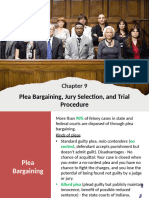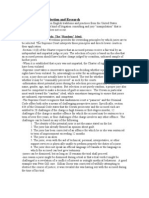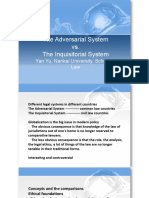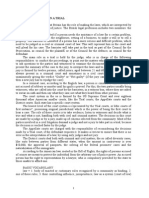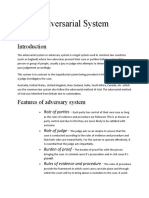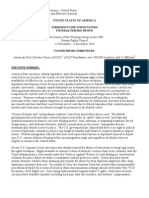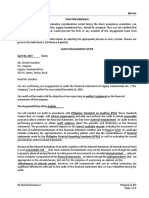9-21 Jury System in US
9-21 Jury System in US
Uploaded by
Iloveyou BhimCopyright:
Available Formats
9-21 Jury System in US
9-21 Jury System in US
Uploaded by
Iloveyou BhimOriginal Description:
Copyright
Available Formats
Share this document
Did you find this document useful?
Is this content inappropriate?
Copyright:
Available Formats
9-21 Jury System in US
9-21 Jury System in US
Uploaded by
Iloveyou BhimCopyright:
Available Formats
Learn About Jury
Service | United States
Courts
Sabas Skills Learning Resource Material
Learn About Jury Service | United States
Courts
Main content
Jury service is a way for U.S. citizens to participate in the judicial process.
Juror Selection
Each district court randomly selects citizens’ names from lists of registered voters and people with drivers licenses
who live in that district. The people randomly selected complete a questionnaire to help determine if they are
quali ed to serve on a jury. Those quali ed are randomly chosen to be summoned to appear for jury duty. This
selection process helps to make sure that jurors represent a cross section of the community, without regard to race,
gender, national origin, age, or political af liation.
Jury Pool to Jury Box
Being summoned for jury service does not guarantee that a person will actually serve on a jury. When a jury is
needed for a trial, the group of quali ed jurors is taken to the courtroom where the trial will take place. The judge
and the attorneys then ask the potential jurors questions to determine their suitability to serve on the jury, a process
called voir dire. The purpose of voir dire is to exclude from the jury people who may not be able to decide the case
fairly. Members of the panel who know any person involved in the case, who have information about the case, or
who may have strong prejudices about the people or issues involved in the case, typically will be excused by the
judge. The attorneys also may exclude a certain number of jurors without giving a reason.
Types of Cases Heard by Juries
There are two types of judicial proceedings in the federal courts that use juries.
1. Criminal trial: An individual is accused of committing a crime that is considered against society as a whole.
Twelve people, and alternates, make up a criminal jury. A unanimous decision must be reached before a
defendant is found “guilty.” The government must prove the crime was committed “beyond a reasonable
doubt.”
Guilty pleas and plea negotiations reduce the need for juries in criminal cases.
2. Civil trial: Litigants seek remedies for private wrongs that don’t necessarily have a broader social impact. At
least six people make up a civil jury. The jury must come to a unanimous decision unless speci ed otherwise.
The standard of proof is a “preponderance of the evidence,” or “more true than not.”
Settlement negotiations reduce the need for juries in civil cases.
Learn About Jury Service | United States Courts
Learn About Jury Service | United States
Courts
Working Together: Judge and Jury
The judge determines the appropriate law that should be applied to the case and the jury nds the facts in the case
based on what is presented to them during the proceedings.
At the end of a trial, the judge instructs the jury on the applicable law. While the jury must obey the judge’s
instructions as to the law, the jury alone is responsible for determining the facts of the case.
Learn About Jury Service | United States Courts
You might also like
- KYC Checklist SpreadsheetDocument56 pagesKYC Checklist Spreadsheetwilliam medrano100% (1)
- Enterprise Wired and Wireless LAN RFP Template: Introduction: How To Use This TemplateDocument14 pagesEnterprise Wired and Wireless LAN RFP Template: Introduction: How To Use This TemplateNestor Adrian LatogaNo ratings yet
- Chris HallDocument15 pagesChris HallNikki GrantNo ratings yet
- The Criminal Trial With The Decision of The JuryDocument6 pagesThe Criminal Trial With The Decision of The JuryCatarina EçaNo ratings yet
- Trial HandbookDocument20 pagesTrial HandbookJulian GrayNo ratings yet
- Why Jury Trials Are Important to a Democratic SocietyDocument2 pagesWhy Jury Trials Are Important to a Democratic Societysujithjacob323No ratings yet
- Jury Trial Analysis Final Cja364Document4 pagesJury Trial Analysis Final Cja364Angela LynchNo ratings yet
- Chapter 13 Lesson 2Document10 pagesChapter 13 Lesson 2api-262327064No ratings yet
- 6 Chapter9Slides PS354 BBDocument53 pages6 Chapter9Slides PS354 BBkayleeorange0507No ratings yet
- Jury Trial Vs Bench TrialDocument4 pagesJury Trial Vs Bench TrialElizaveta MozgoNo ratings yet
- Chapter 8: Jury Selection and ResearchDocument15 pagesChapter 8: Jury Selection and ResearchBreanne KrystynNo ratings yet
- Juror SelectionDocument5 pagesJuror SelectionSpy catNo ratings yet
- Jury Nullification Toolkit FinalDocument56 pagesJury Nullification Toolkit Finalfakey mcalias100% (1)
- Jury SytemDocument2 pagesJury SytemBrian DuelaNo ratings yet
- Study Guide 2Document4 pagesStudy Guide 2Fernanda Guizar ContrerasNo ratings yet
- Jury ArticleDocument2 pagesJury Articleturcitubianca28No ratings yet
- The Adversarial Vs Inquisitorial System PDFDocument41 pagesThe Adversarial Vs Inquisitorial System PDFsudhanshuNo ratings yet
- The Jury in The U.SDocument14 pagesThe Jury in The U.SLăcrămioara BodnarescuNo ratings yet
- Jury 2Document4 pagesJury 2Salman MushtaqNo ratings yet
- Genesee County Bar Association and Genesee County Bar Foundation PresentsDocument41 pagesGenesee County Bar Association and Genesee County Bar Foundation PresentsLoly R. PomaNo ratings yet
- BlanchetteC-Trial Alexander-Role of A Judge PDFDocument2 pagesBlanchetteC-Trial Alexander-Role of A Judge PDFchhaayaachitran akshuNo ratings yet
- Ladrea Calhoun - Impartial JuryDocument3 pagesLadrea Calhoun - Impartial Juryapi-719548586No ratings yet
- Trial by Jury SystemDocument38 pagesTrial by Jury SystemSun Moon100% (2)
- Trials, Basic Trial Procedure & Common Crimes: Civil CaseDocument18 pagesTrials, Basic Trial Procedure & Common Crimes: Civil CaseAtty GheNo ratings yet
- Judicial: Techniques Cases InvolvingDocument15 pagesJudicial: Techniques Cases InvolvingTracy Ewing100% (2)
- Criminal Law 3Document25 pagesCriminal Law 3LilliaNo ratings yet
- HSC Legal Chapter3Document3 pagesHSC Legal Chapter3sophieminissaleNo ratings yet
- The Jury Duty - US Government and Politics | Children's Government BooksFrom EverandThe Jury Duty - US Government and Politics | Children's Government BooksNo ratings yet
- Lesson 2 - Court System and Key PlayersDocument12 pagesLesson 2 - Court System and Key PlayersShannon LitvinNo ratings yet
- Jury SystemDocument7 pagesJury Systemzena ayacheNo ratings yet
- Civil LawDocument3 pagesCivil LawLâm Vũ Ngọc AnhNo ratings yet
- How The Courts Operate - Learn - Unified Judicial System of PennsylvaniaDocument2 pagesHow The Courts Operate - Learn - Unified Judicial System of PennsylvaniaLucas RochaNo ratings yet
- Lori Steinbach: Dislike LikeDocument14 pagesLori Steinbach: Dislike LikeElvin Nobleza PalaoNo ratings yet
- Role of JudgesDocument21 pagesRole of Judgeschidige sai varnithaNo ratings yet
- Unit - IDocument34 pagesUnit - IAum KarNo ratings yet
- Grand Jury - Description, Purpose, History, & Facts - BritannicaDocument6 pagesGrand Jury - Description, Purpose, History, & Facts - Britannicadee.liver777No ratings yet
- Adversarial Vs Inquisitional SystemDocument9 pagesAdversarial Vs Inquisitional SystemAkshat SinhaNo ratings yet
- Courtroom WorkgroupDocument6 pagesCourtroom WorkgroupBobbi Jo EarlNo ratings yet
- How Jurors Are SelectedDocument9 pagesHow Jurors Are SelectedSelin CuhadarogluNo ratings yet
- CourtsDocument19 pagesCourtsMuhammad Jawad AbidNo ratings yet
- Crim Law OutlineDocument33 pagesCrim Law OutlinelaustionNo ratings yet
- Chapter 6 - p180-211 (2) - UnlockedDocument32 pagesChapter 6 - p180-211 (2) - UnlockedAntonio ClairNo ratings yet
- Without Merit - Judicial MisconductDocument10 pagesWithout Merit - Judicial MisconductSLAVEFATHERNo ratings yet
- Textes English For Law UmeciDocument15 pagesTextes English For Law UmeciDesire GBOGOUNo ratings yet
- Introduction To Law - Intro Unit and Notes - UpdatedDocument46 pagesIntroduction To Law - Intro Unit and Notes - UpdatedHassan EL AZZOUZINo ratings yet
- Comparative Criminal Procedure - Adversial and Inuisatorial System NewDocument39 pagesComparative Criminal Procedure - Adversial and Inuisatorial System Newarchit jainNo ratings yet
- Texte Drept EnglezaDocument59 pagesTexte Drept EnglezaAnonymous 82ZQH1eqFKNo ratings yet
- Jurisdictional Menas of Resolving ConflictsDocument3 pagesJurisdictional Menas of Resolving ConflictsAli RzayevNo ratings yet
- 2 Civil Law and 5 JuryDocument3 pages2 Civil Law and 5 JuryAngie Doreen KhoNo ratings yet
- Business Research Methods (BRM) (BBA-6) Assignment # 03: Date:29-March-2020Document9 pagesBusiness Research Methods (BRM) (BBA-6) Assignment # 03: Date:29-March-2020Fahad AyubNo ratings yet
- BFI 2015 LD Jury NullificationDocument21 pagesBFI 2015 LD Jury NullificationBrandonNo ratings yet
- Yuriy Petruncio LECTURE NOTESDocument34 pagesYuriy Petruncio LECTURE NOTESyuriypetruncio09No ratings yet
- Ifferent Types of Courts: N L U, J S S (J - N 2018)Document13 pagesIfferent Types of Courts: N L U, J S S (J - N 2018)Shrikant RamtekeNo ratings yet
- The Concept of A Fair Trial Is A Fundamental Aspect of The Justice System in Both The United States and IndiaDocument7 pagesThe Concept of A Fair Trial Is A Fundamental Aspect of The Justice System in Both The United States and Indiaarchanapradhan1803No ratings yet
- StaffEng Instruction JudicialDocument10 pagesStaffEng Instruction Judicialaplite54808No ratings yet
- RESUMEN The Judicial System (US)Document10 pagesRESUMEN The Judicial System (US)MelanieNo ratings yet
- Texte Drept Si Ap ID-PASTEDocument66 pagesTexte Drept Si Ap ID-PASTECorina GhidiaNo ratings yet
- Episode14LegalProcess PDFDocument4 pagesEpisode14LegalProcess PDFKhaye PagulayanNo ratings yet
- Adversarial System: Role of PartiesDocument3 pagesAdversarial System: Role of PartiesAnish GargNo ratings yet
- CFE - Law Exam PreparationDocument6 pagesCFE - Law Exam PreparationMoinul Ahsan100% (1)
- Upr Submission 20100419Document19 pagesUpr Submission 20100419Ramona OrtegaNo ratings yet
- Com 1 UnscwDocument16 pagesCom 1 UnscwashleyNo ratings yet
- Gec09 PPT3Document69 pagesGec09 PPT3Abigail CaagbayNo ratings yet
- Resolution: Deokma Eight Trading, IncDocument3 pagesResolution: Deokma Eight Trading, IncRALSTON TUYOKNo ratings yet
- 2020 Joint MDB Report On Climate Finance - Report - Final WebDocument64 pages2020 Joint MDB Report On Climate Finance - Report - Final WebSiddhartha ShekharNo ratings yet
- PROPOSAL FTBI 2023 KORWIL BaeDocument15 pagesPROPOSAL FTBI 2023 KORWIL BaeDwi Panti RahayuNo ratings yet
- Rapport-Marco-Polo-Hunter-Famille-Biden (1) (1) - Pages-114Document5 pagesRapport-Marco-Polo-Hunter-Famille-Biden (1) (1) - Pages-114cofutefNo ratings yet
- Amier Affandi - The College of Southern Nevada - Application For Admission-DCSDocument6 pagesAmier Affandi - The College of Southern Nevada - Application For Admission-DCSPenyembah CuanNo ratings yet
- Supreme Courts Under Pressure: Pablo Bravo-Hurtado Cornelis Hendrik Van Rhee EditorsDocument232 pagesSupreme Courts Under Pressure: Pablo Bravo-Hurtado Cornelis Hendrik Van Rhee EditorsFelipe RodolfoNo ratings yet
- Ylarde Et Al. vs. Aquino, Et Al., G.R. No. L-33722, 29 July 1988Document2 pagesYlarde Et Al. vs. Aquino, Et Al., G.R. No. L-33722, 29 July 1988Ogie Rose BanasanNo ratings yet
- Week 5 - IRAC Rough DraftDocument5 pagesWeek 5 - IRAC Rough Draftplaidon1No ratings yet
- SOC 1110 IDE PAST EXAMINATION ANSWERS 2021bDocument48 pagesSOC 1110 IDE PAST EXAMINATION ANSWERS 2021bmbalauelijahNo ratings yet
- Procuerment MGT AssignmentDocument11 pagesProcuerment MGT AssignmentKeyah NkonghoNo ratings yet
- Dissertations and Discussions John Stuart MillDocument7 pagesDissertations and Discussions John Stuart MillPayForPaperMurfreesboro100% (1)
- Mathematics April 2011 LET Room Assignments-LegazpiDocument13 pagesMathematics April 2011 LET Room Assignments-LegazpiproffsgNo ratings yet
- 2 - Time - Scale - Promotion - BPS - 16 - and - AboveDocument9 pages2 - Time - Scale - Promotion - BPS - 16 - and - AboveKhalid Hussain100% (1)
- Tarification Automobile Vp/Ci 510Document15 pagesTarification Automobile Vp/Ci 510ousmane100% (1)
- 06 Task Performance 1 (F) PDFDocument3 pages06 Task Performance 1 (F) PDFFritch SolisNo ratings yet
- Eusebio Vs IAC GR L-63996 Sept 15 1989Document2 pagesEusebio Vs IAC GR L-63996 Sept 15 1989Nicole IbayNo ratings yet
- Land Bank of The Philippines V. Narciso L. Kho G.R. No. 205839 July 07, 2016Document3 pagesLand Bank of The Philippines V. Narciso L. Kho G.R. No. 205839 July 07, 2016Michael Vincent BautistaNo ratings yet
- Attachment RBI SEBI NABARD Feb Compiled 2020 With Finance Lyst3549 PDFDocument178 pagesAttachment RBI SEBI NABARD Feb Compiled 2020 With Finance Lyst3549 PDFGautam IyerNo ratings yet
- Taneps Workshop: Tanzania National E-Procurement SystemDocument12 pagesTaneps Workshop: Tanzania National E-Procurement SystemTale MaremboNo ratings yet
- AMABHUNGANE CENTRE FOR INVESTIGATIVE JOURNALISM NPC AND ANOTHER V MINISTER OF JUSTICE AND CORRECTIONAL SERVICES AND OTHERS 2021 (3) SA 246 (CC)Document28 pagesAMABHUNGANE CENTRE FOR INVESTIGATIVE JOURNALISM NPC AND ANOTHER V MINISTER OF JUSTICE AND CORRECTIONAL SERVICES AND OTHERS 2021 (3) SA 246 (CC)Bessie RamorogoNo ratings yet
- Developmental Counseling Form: Leader's Facts and Observations Prior To The Counseling.)Document2 pagesDevelopmental Counseling Form: Leader's Facts and Observations Prior To The Counseling.)Deontaye BibbsNo ratings yet
- QUIZ1Document6 pagesQUIZ1Shaine Astrid AfableNo ratings yet
- The Aryan Jesus in America - Asynchronus Lecture From April 18 2023Document3 pagesThe Aryan Jesus in America - Asynchronus Lecture From April 18 2023Helen GeckleNo ratings yet
- UNODC Criminal Intelligence Manual For AnalystsDocument104 pagesUNODC Criminal Intelligence Manual For AnalystsIoana FNo ratings yet
- Razred - Vasas-Judit-Etude-In-C-MajorDocument3 pagesRazred - Vasas-Judit-Etude-In-C-MajoraleksandraNo ratings yet
- Contemporary World Lesson 3-5Document28 pagesContemporary World Lesson 3-5Evelyn Medina100% (1)








